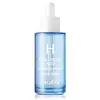What's inside
What's inside
 Key Ingredients
Key Ingredients

 Benefits
Benefits

 Concerns
Concerns

 Ingredients Side-by-side
Ingredients Side-by-side

Sedum Sarmentosum Extract 65.33%
HumectantButylene Glycol
HumectantWater
Skin Conditioning1,2-Hexanediol
Skin ConditioningGlycerin
HumectantGlycereth-26
HumectantPolyglutamic Acid
Skin ConditioningHydrolyzed Hyaluronic Acid
HumectantCeramide NP
Skin ConditioningXylitylglucoside
HumectantAnhydroxylitol
HumectantXylitol
HumectantDipotassium Glycyrrhizate
HumectantCitrus Tangerina Peel Oil
MaskingPelargonium Graveolens Flower Oil
MaskingLavandula Angustifolia Oil
MaskingGlucose
HumectantPhospholipids
Skin ConditioningDiethoxyethyl Succinate
SolventCaprylic/Capric Triglyceride
MaskingAmmonium Acryloyldimethyltaurate/Vp Copolymer
Hydrogenated Lecithin
EmulsifyingC12-13 Pareth-9
EmulsifyingDisodium EDTA
Chlorphenesin
AntimicrobialSedum Sarmentosum Extract 65.33%, Butylene Glycol, Water, 1,2-Hexanediol, Glycerin, Glycereth-26, Polyglutamic Acid, Hydrolyzed Hyaluronic Acid, Ceramide NP, Xylitylglucoside, Anhydroxylitol, Xylitol, Dipotassium Glycyrrhizate, Citrus Tangerina Peel Oil, Pelargonium Graveolens Flower Oil, Lavandula Angustifolia Oil, Glucose, Phospholipids, Diethoxyethyl Succinate, Caprylic/Capric Triglyceride, Ammonium Acryloyldimethyltaurate/Vp Copolymer, Hydrogenated Lecithin, C12-13 Pareth-9, Disodium EDTA, Chlorphenesin
Water
Skin ConditioningDipropylene Glycol
HumectantGlycerin
HumectantNiacinamide
SmoothingCeramide AP
Skin Conditioning1,2-Hexanediol
Skin ConditioningSodium Hyaluronate Crosspolymer
HumectantHydrolyzed Glycosaminoglycans
HumectantHydrolyzed Hyaluronic Acid
HumectantHyaluronic Acid
HumectantSaccharomyces/Viscum Album Ferment Extract
Skin ConditioningSaccharomyces/Imperata Cylindrica Root Ferment Extract
EmollientLactobacillus/Soybean Ferment Extract
Skin ConditioningSodium Hyaluronate
HumectantBetaine
HumectantPPG-2-Deceth-12
EmulsifyingPolyglutamic Acid
Skin ConditioningBrassica Campestris Extract
Skin ConditioningPrunus Yedoensis Flower Extract
HumectantPaeonia Suffruticosa Root Extract
Skin ProtectingPortulaca Oleracea Extract
Skin ConditioningAdenosine
Skin ConditioningAmmonium Acryloyldimethyltaurate/Vp Copolymer
Panthenol
Skin ConditioningAllantoin
Skin ConditioningDisodium EDTA
Ethylhexylglycerin
Skin ConditioningParfum
MaskingLimonene
PerfumingLinalool
PerfumingButylphenyl Methylpropional
PerfumingWater, Dipropylene Glycol, Glycerin, Niacinamide, Ceramide AP, 1,2-Hexanediol, Sodium Hyaluronate Crosspolymer, Hydrolyzed Glycosaminoglycans, Hydrolyzed Hyaluronic Acid, Hyaluronic Acid, Saccharomyces/Viscum Album Ferment Extract, Saccharomyces/Imperata Cylindrica Root Ferment Extract, Lactobacillus/Soybean Ferment Extract, Sodium Hyaluronate, Betaine, PPG-2-Deceth-12, Polyglutamic Acid, Brassica Campestris Extract, Prunus Yedoensis Flower Extract, Paeonia Suffruticosa Root Extract, Portulaca Oleracea Extract, Adenosine, Ammonium Acryloyldimethyltaurate/Vp Copolymer, Panthenol, Allantoin, Disodium EDTA, Ethylhexylglycerin, Parfum, Limonene, Linalool, Butylphenyl Methylpropional
Ingredients Explained
These ingredients are found in both products.
Ingredients higher up in an ingredient list are typically present in a larger amount.
1,2-Hexanediol is a synthetic liquid and another multi-functional powerhouse.
It is a:
- Humectant, drawing moisture into the skin
- Emollient, helping to soften skin
- Solvent, dispersing and stabilizing formulas
- Preservative booster, enhancing the antimicrobial activity of other preservatives
Ammonium Acryloyldimethyltaurate/Vp Copolymer (let's call it AAVC for short) is a synthetically created polymer. It's used as a film-forming agent and used to thicken the consistency of products.
AAVC is able to increase the consistency and viscosity of products due to its large molecule size. It also prevents ingredients from separating.
Disodium EDTA plays a role in making products more stable by aiding other preservatives.
It is a chelating agent, meaning it neutralizes metal ions that may be found in a product.
Disodium EDTA is a salt of edetic acid and is found to be safe in cosmetic ingredients.
Learn more about Disodium EDTAGlycerin is already naturally found in your skin. It helps moisturize and protect your skin.
A study from 2016 found glycerin to be more effective as a humectant than AHAs and hyaluronic acid.
As a humectant, it helps the skin stay hydrated by pulling moisture to your skin. The low molecular weight of glycerin allows it to pull moisture into the deeper layers of your skin.
Hydrated skin improves your skin barrier; Your skin barrier helps protect against irritants and bacteria.
Glycerin has also been found to have antimicrobial and antiviral properties. Due to these properties, glycerin is often used in wound and burn treatments.
In cosmetics, glycerin is usually derived from plants such as soybean or palm. However, it can also be sourced from animals, such as tallow or animal fat.
This ingredient is organic, colorless, odorless, and non-toxic.
Glycerin is the name for this ingredient in American English. British English uses Glycerol/Glycerine.
Learn more about GlycerinHydrolyzed Hyaluronic Acid is a form of hyaluronic acid. It is created by the hydrolysis of hyaluronic acid with a high molecular weight. Once created, Hydrolyzed Hyaluronic Acid has a low molecular weight.
Low molecular weight HA has been shown to hydrate and increase elasticity of the skin. Increasing elasticity is also associated with reduction of wrinkle depth.
One study found topical low molecular weight hyaluronic acid may be considered for the treatment of rosacea in the adult population. However, we always recommend speaking with a professional about your skin concerns.
Hyaluronic acids are a humectant. This means they draw moisture from the air. Hyaluronic acids help moisturize, soothe, and protect the skin.
Read more about other common forms of hyaluronic acid:
Learn more about Hydrolyzed Hyaluronic AcidPolyglutamic Acid is made up many glutamic acids chained together. It is created from bacterial fermentation.
This ingredient is an effective skin hydrator and may help speed up wound healing. As a humectant, it draws and holds water to the skin. This ingredient is often compared to hyaluronic acid or glycerin. Similarly to hyaluronic acid, it can vary in molecular weights. This means polyglutamic acid is capable of bringing hydration to lower levels of the skin.
Fun fact: Polyglutamic Acid is found in the Japanese food, natto. It is also being used in cancer treatment studies.
Learn more about Polyglutamic AcidWater. It's the most common cosmetic ingredient of all. You'll usually see it at the top of ingredient lists, meaning that it makes up the largest part of the product.
So why is it so popular? Water most often acts as a solvent - this means that it helps dissolve other ingredients into the formulation.
You'll also recognize water as that liquid we all need to stay alive. If you see this, drink a glass of water. Stay hydrated!
Learn more about Water